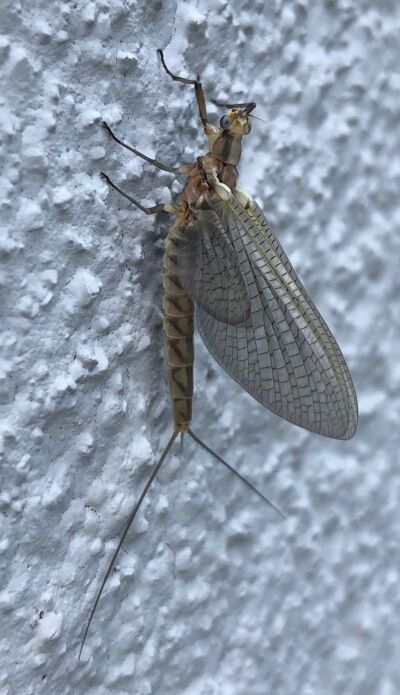
Fishflies have started arriving in lakefront communities. The winged insects could be found clinging to The War Memorial — on Lake St. Clair in Grosse Pointe Farms — on June 14.
Photo by K. Michelle Moran
METRO DETROIT — If you live or work somewhere close to Lake St. Clair, you’re likely familiar with fishflies — the winged insects that seem to arrive in swarms every summer, covering buildings, fluttering around streetlights after dark, and dying en masse under said streetlights, creating stinky piles of bug carcasses.
Several hundred fishflies could be seen on the campus of The War Memorial in Grosse Pointe Farms June 14, and David Lowenstein, an entomologist and consumer horticulture extension educator with the Michigan State University Extension Center, said he spotted some in St. Clair Shores a few days earlier.
“They’ve been out for about a week or so,” Lowenstein said when reached by phone June 14. “Anytime within the next two weeks would be right on track (for their arrival).”
They emerge in batches of thousands to millions over a roughly two- to three-week period each summer.
Fishflies — which are technically mayflies — might seem like a nuisance, especially for business owners who find themselves clearing scores of them off their windows and buildings, but they play a vital role in the ecosystem.
Lowenstein said the insects “spend the majority of their lives” in the water — about one to three years. In this larvae phase, he said, they are an important food source for fish, which will also dine on fishflies that happen to land on the surface of the water.
They’re also a sign that the lakes are relatively clean and not full of pollutants.
“They only emerge where the water quality is good and there’s a lot of dissolved oxygen,” Lowenstein said. “We actually want there to be a large emergence of fishflies.”
The insects are really only seen in communities adjacent to large bodies of water, such as the Grosse Pointes, St. Clair Shores and Harrison Township, Lowenstein said.
“You only see them (in this area) if you’re 1 to 2 miles from Lake St. Clair,” Lowenstein said.
Fishflies emerge from the water in a subimago phase, where their wings aren’t fully developed yet, Lowenstein said. They only live for approximately one to two days outside the water, because they don’t have mouth parts as fishflies and therefore can’t eat. During this time, male fishflies mate with their female counterparts, the latter of which then return to the water to lay their eggs.
While their large numbers might look intimidating, fishflies neither bite nor sting.
“They’re a little annoying and they smell fishy, but they’re no threat to you or your garden,” Lowenstein said.
Lowenstein said there are more than 100 different species of fishflies/mayflies, the most common of which in this area is the Hex mayfly.
For a variety of bird species, fishflies are an easy food source.
Drivers need to be cautious because piles of dead fishflies on roadways can create slick spots, but otherwise, these insects don’t pose a threat to anyone.
“You don’t need to take any action if you find fishflies,” Lowenstein said.
These insects can be found all over the country, not just in the Great Lakes region; anywhere there’s a large body of water — such as the Mississippi River — people can find fishflies, Lowenstein said. There are just more of them in Michigan because of the prevalence of multiple large bodies of water, such as Lake St. Clair.
 Publication select ▼
Publication select ▼






















